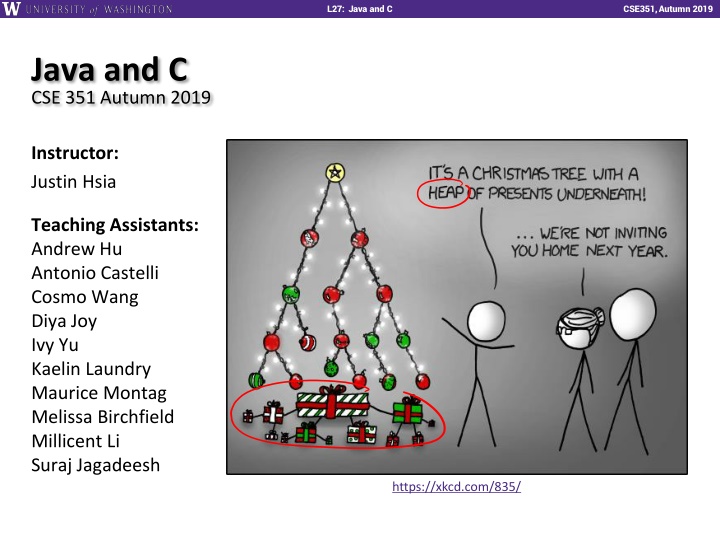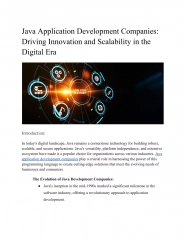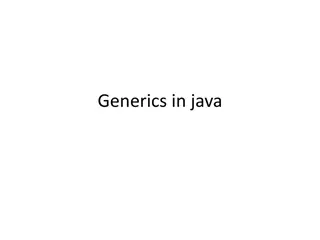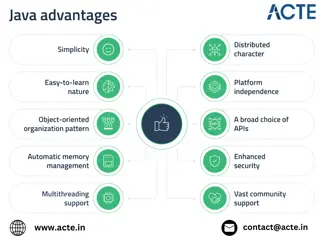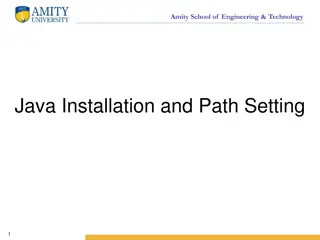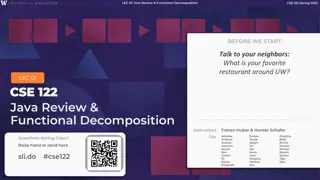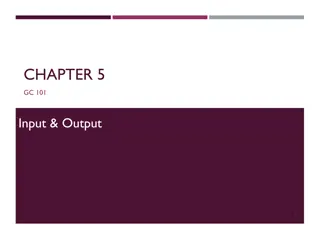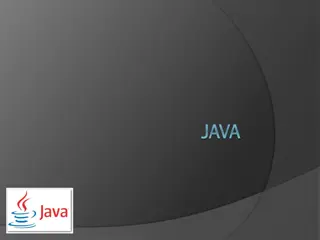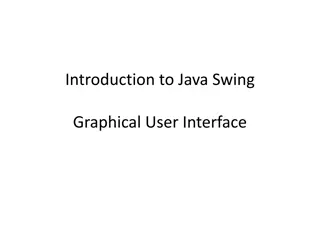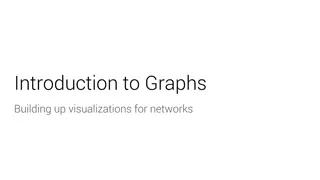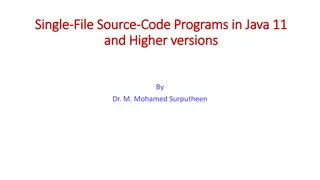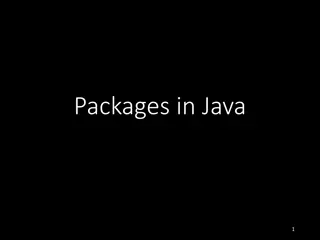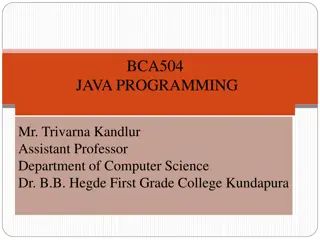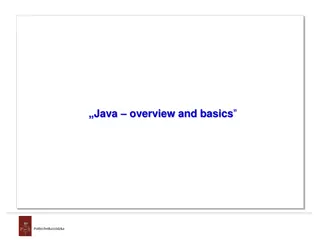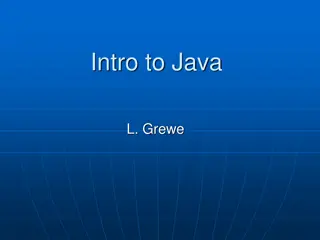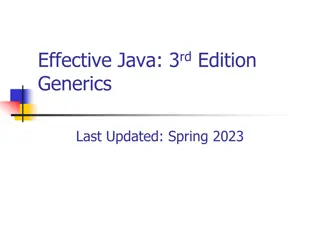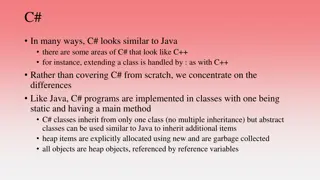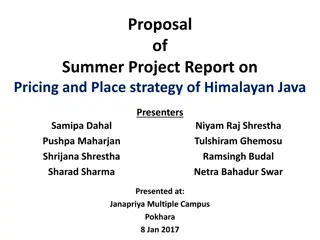Java and C
CSE351 presents a different perspective on computing and program execution compared to Java. Explore the contrasts and connections between the two languages, bridging the gap between high and low-level abstractions.
Download Presentation

Please find below an Image/Link to download the presentation.
The content on the website is provided AS IS for your information and personal use only. It may not be sold, licensed, or shared on other websites without obtaining consent from the author.If you encounter any issues during the download, it is possible that the publisher has removed the file from their server.
You are allowed to download the files provided on this website for personal or commercial use, subject to the condition that they are used lawfully. All files are the property of their respective owners.
The content on the website is provided AS IS for your information and personal use only. It may not be sold, licensed, or shared on other websites without obtaining consent from the author.
E N D
Presentation Transcript
L27: Java and C CSE351, Autumn 2019 Java and C CSE 351 Autumn 2019 Instructor: Justin Hsia Teaching Assistants: Andrew Hu Antonio Castelli Cosmo Wang Diya Joy Ivy Yu Kaelin Laundry Maurice Montag Melissa Birchfield Millicent Li Suraj Jagadeesh https://xkcd.com/835/
L27: Java and C CSE351, Autumn 2019 Administrivia Lab 5 due Friday (12/6) Hard deadline on Sunday (12/8) 1 late day Course evaluations now open See Piazza post @597 for links (separate for Lec and Sec) Final Exam: Tue, 12/10, 12:30-2:20 pm in KNE 120 Review Session: Sun, 12/8, 3:30 6 pm in SAV 260 You get TWO double-sided handwritten 8.5 11 cheat sheets 2
L27: Java and C CSE351, Autumn 2019 Roadmap C: Memory & data Integers & floats x86 assembly Procedures & stacks Executables Arrays & structs Memory & caches Processes Virtual memory Memory allocation Java vs. C Java: Car c = new Car(); c.setMiles(100); c.setGals(17); float mpg = c.getMPG(); car *c = malloc(sizeof(car)); c->miles = 100; c->gals = 17; float mpg = get_mpg(c); free(c); Assembly language: get_mpg: pushq %rbp movq %rsp, %rbp ... popq %rbp ret OS: Machine code: 0111010000011000 100011010000010000000010 1000100111000010 110000011111101000011111 Computer system: 3
L27: Java and C CSE351, Autumn 2019 Java vs. C Reconnecting to Java (hello CSE143!) But now you know a lot more about what really happens when we execute programs We ve learned about the following items in C; now we ll see what they look like for Java: Representation of data Pointers / references Casting Function / method calls including dynamic dispatch 4
L27: Java and C CSE351, Autumn 2019 Worlds Colliding CSE351 has given you a really different feeling about what computers do and how programs execute We have occasionally contrasted to Java, but CSE143 may still feel like a different world It s not it s just a higher-level of abstraction Connect these levels via how-one-could-implement-Java in 351 terms 5
L27: Java and C CSE351, Autumn 2019 Meta-point to this lecture None of the data representations we are going to talk about are guaranteed by Java In fact, the language simply provides an abstraction (Java language specification) Tells us how code should behave for different language constructs, but we can't easily tell how things are really represented But it is important to understand an implementation of the lower levels useful in thinking about your program 6
L27: Java and C CSE351, Autumn 2019 Data in Java Integers, floats, doubles, pointers same as C Pointers are called references in Java, but are much more constrained than C s general pointers Java s portability-guarantee fixes the sizes of all types Example: int is 4 bytes in Java regardless of machine No unsigned types to avoid conversion pitfalls Added some useful methods in Java 8 (also use bigger signed types) null is typically represented as 0but you can t tell Much more interesting: Arrays Characters and strings Objects 7
L27: Java and C CSE351, Autumn 2019 Data in Java: Arrays Every element initialized to 0 or null Length specified in immutable field at start of array (int 4 bytes) array.lengthreturns value of this field Since it has this info, what can it do? int array[5]; C: ?? ?? ?? ?? ?? 0 int[] array = new int[5]; 4 20 Java: 5 00 00 00 00 00 4 0 20 24 8
L27: Java and C CSE351, Autumn 2019 Data in Java: Arrays Every element initialized to 0 or null Length specified in immutable field at start of array (int 4 bytes) array.length returns value of this field Every access triggers a bounds-check Code is added to ensure the index is within bounds Exception if out-of-bounds int array[5]; To speed up bounds-checking: Length field is likely in cache Compiler may store length field in register for loops Compiler may prove that some checks are redundant C: ?? ?? ?? ?? ?? 0 int[] array = new int[5]; 4 20 Java: 5 00 00 00 00 00 4 0 20 24 9
L27: Java and C CSE351, Autumn 2019 Data in Java: Characters & Strings Two-byte Unicode instead of ASCII Represents most of the world s alphabets String not bounded by a '\0' (null character) Bounded by hidden length field at beginning of string All String objects read-only (vs. StringBuffer) Example: the string CSE351 C: (ASCII) 43 0 53 45 33 35 31 \0 7 1 4 Java: (Unicode) 6 43 00 53 00 45 00 33 00 35 00 31 00 4 8 0 16 10
L27: Java and C CSE351, Autumn 2019 Data in Java: Objects Data structures (objects) are always stored by reference, never stored inline Include complex data types (arrays, other objects, etc.) using references C: structrec { int i; int a[3]; structrec *p; }; Java: classRec { int i; int[] a = new int[3]; Rec p; ... } a[]stored inline as part of struct a stored by reference in object i a 4 p i a 4 p 12 20 0 0 16 24 3 0 4 16 11
L27: Java and C CSE351, Autumn 2019 Pointer/reference fields and variables In C, we have -> and . for field selection depending on whether we have a pointer to a struct or a struct (*r).ais so common it becomes r->a In Java, all non-primitive variables are references to objects We always use r.a notation But really follow reference to r with offset to a, just like r->a in C So no Java field needs more than 8 bytes C: Java: structrec*r = malloc(...); structrec r2; r->i = val; r->a[2] = val; r->p = &r2; r = new Rec(); r2 = new Rec(); r.i = val; r.a[2] = val; r.p = r2; 12
L27: Java and C CSE351, Autumn 2019 Pointers/References Pointers in C can point to any memory address References in Java can only point to [the starts of] objects Can only be dereferenced to access a field or element of that object C: Java: structrec { int i; int a[3]; structrec*p; }; structrec* r = malloc( ); some_fn(&(r->a[1])); // ptr r classRec { int i; int[] a = new int[3]; Rec p; } Rec r = new Rec(); some_fn(r.a, 1); // ref, index r i a p 0 4 12 i a 4 p 20 0 16 24 3 int[3] 0 4 16 13
L27: Java and C CSE351, Autumn 2019 Casting in C (example from Lab 5) Can cast any pointer into any other pointer Changes dereference and arithmetic behavior struct BlockInfo { size_t sizeAndTags; structBlockInfo* next; structBlockInfo* prev; }; typedef struct BlockInfo BlockInfo; ... int x; BlockInfo *b; BlockInfo *newBlock; ... newBlock = (BlockInfo *) ( (char *) b + x ); ... Cast b into char* to do unscaled addition Cast back into BlockInfo* to use as BlockInfo struct s n p 8 s n p 0 16 24 x 14
L27: Java and C CSE351, Autumn 2019 Type-safe casting in Java Can only cast compatible object references Based on class hierarchy class Boat extends Vehicle { int propellers; } class Object { ... } class Vehicle { int passengers; } class Car extends Vehicle { int wheels; } Vehicle v = new Vehicle(); // super class of Boat and Car Boat b1 = new Boat(); // |--> sibling Car c1 = new Car(); // |--> sibling Vehicle v1 = new Car(); Vehicle v2 = v1; Car c2 = new Boat(); Car c3 = new Vehicle(); Boat b2 = (Boat) v; Car c4 = (Car) v2; Car c5 = (Car) b1; 15
L27: Java and C CSE351, Autumn 2019 Type-safe casting in Java Can only cast compatible object references Based on class hierarchy class Boat extends Vehicle { int propellers; } class Object { ... } class Vehicle { int passengers; } class Car extends Vehicle { int wheels; } Vehicle v = new Vehicle(); // super class of Boat and Car Boat b1 = new Boat(); // |--> sibling Car c1 = new Car(); // |--> sibling Everything needed for Vehicle also in Car v1 is declared as type Vehicle Compiler error: Incompatible type elements in Car that are not in Boat (siblings) Compiler error: Wrong direction elements Car not in Vehicle (wheels) Runtime error: Vehicle does not contain all elements in Boat (propellers) v2 refers to a Car at runtime Compiler error: Unconvertable types b1 is declared as type Boat Vehicle v1 = new Car(); Vehicle v2 = v1; Car c2 = new Boat(); Car c3 = new Vehicle(); Boat b2 = (Boat) v; Car c4 = (Car) v2; Car c5 = (Car) b1; 16
L27: Java and C CSE351, Autumn 2019 Java Object Definitions classPoint { double x; double y; fields Point() { x = 0; y = 0; } constructor boolean samePlace(Point p) { return (x == p.x) && (y == p.y); } } ... Point p = new Point(); ... method(s) creation 17
L27: Java and C CSE351, Autumn 2019 Java Objects and Method Dispatch Point object p header vptr x y vtable for class Point: code for samePlace() code for Point() Point object q header vptr x y Virtual method table (vtable) Like a jump table for instance ( virtual ) methods plus other class info One table per class Each object instance contains a vtable pointer (vptr) Object header : GC info, hashing info, lock info, etc. 18
L27: Java and C CSE351, Autumn 2019 Java Constructors When we call new: allocate space for object (data fields and references), initialize to zero/null, and run constructor method Java: C pseudo-translation: Point p = new Point(); Point* p = calloc(1,sizeof(Point)); p->header = ...; p->vptr = &Point_vtable; p->vptr[0](p); Point object p header vptr x y vtable for class Point: code for samePlace() code for Point() 19
L27: Java and C CSE351, Autumn 2019 Java Methods Static methods are just like functions Instance methods: Can refer to this; Have an implicit first parameter for this; and Can be overridden in subclasses The code to run when calling an instance method is chosen at runtime by lookup in the vtable Java: C pseudo-translation: p.samePlace(q); p->vptr[1](p, q); Point object p header vptr x y vtable for class Point: code for samePlace() code for Point() 20
L27: Java and C CSE351, Autumn 2019 Subclassing class ThreeDPoint extends Point { double z; boolean samePlace(Point p2) { return false; } void sayHi() { System.out.println("hello"); } } Where does z go? At end of fields of Point Point fields are always in the same place, so Point code can run on ThreeDPoint objects without modification Where does pointer to code for two new methods go? No constructor, so use default Point constructor To override samePlace , use same vtable position Add new pointer at end of vtable for new method sayHi 21
L27: Java and C CSE351, Autumn 2019 Subclassing class ThreeDPoint extends Point { double z; boolean samePlace(Point p2) { return false; } void sayHi() { System.out.println("hello"); } } z tacked on at end ThreeDPoint object header vptr x y z sayHi tacked on at end Code for sayHi vtable for ThreeDPoint: (not Point) constructor samePlace sayHi New code for samePlace Old code for constructor 22
L27: Java and C CSE351, Autumn 2019 Dynamic Dispatch Point object header vptr x y Point vtable: p ??? code for Point s samePlace() code for Point() ThreeDPoint object header vptr x y z code for sayHi() ThreeDPoint vtable: code for 3DPoint s samePlace() Java: C pseudo-translation: Point p = ???; return p.samePlace(q); // works regardless of what p is return p->vptr[1](p, q); 23
L27: Java and C CSE351, Autumn 2019 Ta-da! In CSE143, it may have seemed magic that an inherited method could call an overridden method You were tested on this endlessly The trick in the implementation is this part: p->vptr[i](p,q) In the body of the pointed-to code, any calls to (other) methods of this will use p->vptr Dispatch determined by p, not the class that defined a method 24
L27: Java and C CSE351, Autumn 2019 Practice Question Assume: 64-bit pointers, Java objects aligned to 8 B with 8-B header What are the sizes of the things being pointed at by ptr_c and ptr_j? structc { int i; char s[3]; int a[3]; structc*p; }; structc* ptr_c; classjobj { int i; String s = "hi"; int[] a = new int[3]; jobj p; } jobj ptr_j = new jobj(); 25
L27: Java and C CSE351, Autumn 2019 We made it! C: Memory & data Integers & floats x86 assembly Procedures & stacks Executables Arrays & structs Memory & caches Processes Virtual memory Memory allocation Java vs. C Java: Car c = new Car(); c.setMiles(100); c.setGals(17); float mpg = c.getMPG(); car *c = malloc(sizeof(car)); c->miles = 100; c->gals = 17; float mpg = get_mpg(c); free(c); Assembly language: get_mpg: pushq %rbp movq %rsp, %rbp ... popq %rbp ret OS: Machine code: 0111010000011000 100011010000010000000010 1000100111000010 110000011111101000011111 Computer system: 26
